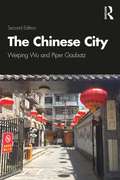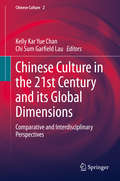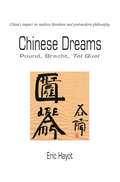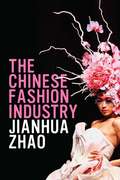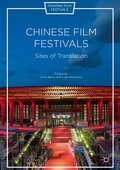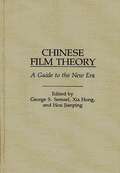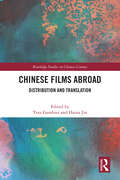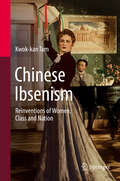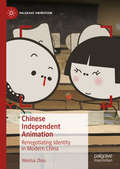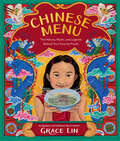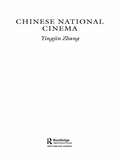- Table View
- List View
The Chinese City
by Weiping Wu Piper GaubatzDrawing on years of research experience and keen observations of the triumphs and problems in China’s cities, the authors provide a foundational understanding of China’s urbanization and cities that is grounded in history and geography and challenges readers to consider Chinese urbanization through multiple disciplinary and thematic lenses. This book is anchored in the spatial sciences, including geography, urban studies, urban planning, and environmental studies. It offers a comprehensive survey of the evolving urban landscape, covering such topics as history and patterns of urbanization, spatial and regional context, models of urban form, economic and social-spatial transformation, urbanism and cultural dynamics, housing and land development, environmental and infrastructure issues, poverty and inequality, and challenges of urban governance. The book highlights both parallels and substantive differences between China and comparable cities and countries elsewhere, given that some urban conditions around the world converge and point to shared catalysts (e.g. internal migration) and globally linked processes (e.g. climate change). It explores the consequences of the demographic, economic, social, and environmental transitions on cities and urban dwellers. Illustrated case studies in each chapter ground the discussion and introduce readers to the diversity of cities and urban life in China. Most chapters also can be used as stand-alone course materials, with suggested references for further reading. Intended for a wide audience in higher education and beyond, this book will be useful to readers interested in Chinese Studies, East Asian Studies, Urban Studies, Urban Geography, or Urban Planning.
The Chinese City (A\world Bank Publication)
by Weiping Wu Piper GaubatzDrawing on years of research experience and keen observations of the triumphs and problems in China’s cities, the authors provide a foundational understanding of China’s urbanization and cities that is grounded in history and geography and challenges readers to consider Chinese urbanization through multiple disciplinary and thematic lenses. This book is anchored in the spatial sciences, including geography, urban studies, urban planning, and environmental studies. It offers a comprehensive survey of the evolving urban landscape, covering such topics as history and patterns of urbanization, spatial and regional context, models of urban form, economic and social-spatial transformation, urbanism and cultural dynamics, housing and land development, environmental and infrastructure issues, poverty and inequality, and challenges of urban governance. The book highlights both parallels and substantive differences between China and comparable cities and countries elsewhere, given that some urban conditions around the world converge and point to shared catalysts (e.g. internal migration) and globally linked processes (e.g. climate change). It explores the consequences of the demographic, economic, social, and environmental transitions on cities and urban dwellers. Illustrated case studies in each chapter ground the discussion and introduce readers to the diversity of cities and urban life in China. Most chapters also can be used as stand-alone course materials, with suggested references for further reading. Intended for a wide audience in higher education and beyond, this book will be useful to readers interested in Chinese Studies, East Asian Studies, Urban Studies, Urban Geography, or Urban Planning.
Chinese Culture in the 21st Century and its Global Dimensions: Comparative and Interdisciplinary Perspectives (Chinese Culture #2)
by Kelly Kar Yue Chan Chi Sum Garfield LauThis book investigates the internationalization of Chinese culture in recent decades and the global dimensions of Chinese culture from comparative and interdisciplinary perspectives. It covers a variety of topics concerning the contemporary significance of Chinese culture in its philosophical, literary and artistic manifestations, including literature, film, performing arts, creative media, linguistics, translations and philosophical ideas. The book explores the reception of Chinese culture in different geographic locations and how the global reception of Chinese culture contrasts with the local Chinese community. The chapters collectively cover gender studies and patriarchal domination in Chinese literature in comparison to the world literature, explorations on translation of Chinese culture in the West, Chinese studies as an academic discipline in the West, and Chinese and Hong Kong films and performances in the global context. The book is an excellent resource for both scholars and students interested in the development of Chinese culture on the global stage in the 21st Century.
Chinese Dreams: Pound, Brecht, Tel Quel
by Eric R. HayotChina’s profound influence on the avant-garde in the 20th century was nowhere more apparent than in the work of Ezra Pound, Bertolt Brecht, and the writers associated with the Parisian literary journal Tel quel. Chinese Dreams explores the complex, intricate relationship between various “Chinas”—as texts—and the nation/culture known simply as “China”—their context—within the work of these writers. Eric Hayot calls into question the very means of representing otherness in the history of the West and ultimately asks if it might be possible to attend to the political meaning of imagining the other, while still enjoying the pleasures and possibilities of such dreaming. The latest edition of this critically acclaimed book includes a new preface by the author. “Lucid and accessible . . . an important contribution to the field of East-West comparative studies, Asian studies, and modernism.” —Comparative Literature Studies “Instead of trying to decipher the indecipherable ‘China’ in Western literary texts and critical discourses, Hayot chose to show us why and how ‘China’ has remained, and will probably always be, an enchanting, ever-elusive dream. His approach is nuanced and refreshing, his analysis rigorous and illuminating.” —Michelle Yeh, University of California, Davis
The Chinese Fashion Industry: An Ethnographic Approach (Dress, Body, Culture)
by Jianhua ZhaoLess than three decades ago, when the Chinese bought cloth or clothes, they would have had to use a government-issued coupon. Today the Chinese fashion industry is one of the most dynamic in the world - it not only supplies fashions to the increasingly discerning domestic market, but also provides one-third of the clothing sold in the global market. How did this phenomenal transition come about? What can the growth of the Chinese fashion industry tell us about the post-Mao China? What roles do the local and the global play in the dramatic changes? This book offers a historically informed, ethnographically grounded and interpretive analysis of contemporary Chinese fashion and the fashion industry. It examines the interplay of state politics, market forces, local social and cultural factors, and the global political economy, both in the rise of the Chinese fashion industry and in the life and work of Chinese fashion professionals. As the first ethnographic account of the Chinese fashion industry in the post-Mao era, The Chinese Fashion Industry combines first-hand accounts with sophisticated cultural analysis to offer new insights, and will be of interest to students and scholars of fashion, anthropology and China.
The Chinese Fashion Industry: An Ethnographic Approach (Dress, Body, Culture)
by Jianhua ZhaoLess than three decades ago, when the Chinese bought cloth or clothes, they would have had to use a government-issued coupon. Today the Chinese fashion industry is one of the most dynamic in the world - it not only supplies fashions to the increasingly discerning domestic market, but also provides one-third of the clothing sold in the global market. How did this phenomenal transition come about? What can the growth of the Chinese fashion industry tell us about the post-Mao China? What roles do the local and the global play in the dramatic changes? This book offers a historically informed, ethnographically grounded and interpretive analysis of contemporary Chinese fashion and the fashion industry. It examines the interplay of state politics, market forces, local social and cultural factors, and the global political economy, both in the rise of the Chinese fashion industry and in the life and work of Chinese fashion professionals. As the first ethnographic account of the Chinese fashion industry in the post-Mao era, The Chinese Fashion Industry combines first-hand accounts with sophisticated cultural analysis to offer new insights, and will be of interest to students and scholars of fashion, anthropology and China.
Chinese Film Festivals: Sites of Translation (Framing Film Festivals)
by Chris Berry Luke RobinsonThis book is the first anthology of research devoted to the booming world of Chinese film festivals, covering both mainstream and independent films. It also explores festivals in the Chinese-speaking world and festivals of Chinese films in the rest of the world. The book asks how Chinese film festivals function as sites of translation, translating Chinese culture to the world and world culture to Chinese-speaking audiences, and also how the international film festival model is being transformed as it is translated into the Chinese-speaking world.
Chinese Film Theory: A Guide to the New Era
by Xia Hong Hou Jianping George S. SemselThis is the first collection of translations of Chinese film theory to be published in English. By using translations rather than summaries, as other works have done, Chinese Film Theory provides readers with an introduction to the issues current in China's film circles. It includes eighteen chapters written by a broad range of writers--from well established scholars to young people at the beginning of their involvement in film in China. This collection indicates a trend away from the study of external qualities of film and toward a study of the film itself.The volume has been carefully organized so that major issues are interrelated; thus, the book comprises an ongoing debate of film theory issues, progressing from earlier to most recent issues, following the debate concerning the relationship of film to literary arts, and looking at the debate over the relationship of film to culture. The book concludes that for the time being, debate has virtually ended because of the political situation in China. This book is an important new source to anyone interested in film studies, film theory, or Chinese studies.
Chinese Films Abroad: Distribution and Translation (Routledge Studies in Chinese Cinema)
by Yves Gambier Haina JinThis book examines Chinese films made and shown abroad roughly between the 1920s and the 2020s, from the beginning of the international exchange of the Chinese national film industry to the emergence of the concept of soft power.The periodisation of Chinese cinema(s) does not necessarily match the political periods: on the one hand, the technical development of the film industry and the organisation of translation in China, and on the other hand, official relations with China and translation policies abroad impose different constraints on the circulation of Chinese films. This volume deals with the distribution and translation of films from mainland China, Taiwan, Hong Kong, and the Chinese diaspora. To this end, the contributors address various issues related to the circulation and distribution of Chinese films, including co- productions, agents of exchange, and modes of translation. The approach is a mixture of socio- cultural and translational methods. The data collected provides, for the first time, a quantitative overview of the circulation of Chinese films in a dozen foreign countries.The book will greatly interest scholars and students of Chinese cinema, translation studies, and China studies.
Chinese Films Abroad: Distribution and Translation (Routledge Studies in Chinese Cinema)
This book examines Chinese films made and shown abroad roughly between the 1920s and the 2020s, from the beginning of the international exchange of the Chinese national film industry to the emergence of the concept of soft power.The periodisation of Chinese cinema(s) does not necessarily match the political periods: on the one hand, the technical development of the film industry and the organisation of translation in China, and on the other hand, official relations with China and translation policies abroad impose different constraints on the circulation of Chinese films. This volume deals with the distribution and translation of films from mainland China, Taiwan, Hong Kong, and the Chinese diaspora. To this end, the contributors address various issues related to the circulation and distribution of Chinese films, including co- productions, agents of exchange, and modes of translation. The approach is a mixture of socio- cultural and translational methods. The data collected provides, for the first time, a quantitative overview of the circulation of Chinese films in a dozen foreign countries.The book will greatly interest scholars and students of Chinese cinema, translation studies, and China studies.
Chinese Films in Focus II
by Chris BerryChinese cinema continues to go from strength to strength. After art-house hits like Chen Kaige's Yellow Earth (1984) and Wong Kar-wai's In the Mood for Love (2000), the Oscar-winning success of Ang Lee's Crouching Tiger Hidden Dragon (2000) disproved the old myth that subtitled films could not succeed at the multiplex. Chinese Films in Focus II updates and expands the original Chinese Films in Focus: 25 New Takes with fourteen brand new essays, to offer thirty-four fresh and insightful readings of key individual films. The new edition addresses films from mainland China, Taiwan, Hong Kong and other parts of the Chinese diaspora and the historical coverage ranges from the 1930s to the present. The essays, by leading authorities on Chinese cinema as well as up-and-coming scholars, are concise, accessible, rich, and on the cutting edge of current research. Each contributor outlines existing writing and presents an original perspective on the film, making this volume a rich resource for classroom use, scholarly research and general reading for anyone wanting to understand more about the historical development and rich variety of Chinese cinema.Contributors: Annette Aw, Chris Berry, Yomi Braester, Felicia Chan, Esther Cheung, Robert Chi, Rey Chow, Mary Farquhar, Carolyn FitzGerald, Ping Fu, Kristine Harris, Margaret Hillenbrand, Brian Hu, Tan See Kam, Haiyan Lee, Vivian Lee, Helen Hok-Sze Leung, David Leiwei Li, Song Hwee Lim, Kam Louie, Fran Martin, Jason McGrath, Corrado Neri, Jonathan Noble, Beremoce Reynaud, Cui Shuqin, Julian Stringer, Janice Tong, Yiman Wang, Faye Hui Xiao, Gang Gary Xu, Audrey Yue, Yingjin Zhang, John ZouThe Editor: Chris Berry is Professor of Film and Television at Goldsmiths, University of London.
Chinese Films in Focus II
by Chris BerryChinese cinema continues to go from strength to strength. After art-house hits like Chen Kaige's Yellow Earth (1984) and Wong Kar-wai's In the Mood for Love (2000), the Oscar-winning success of Ang Lee's Crouching Tiger Hidden Dragon (2000) disproved the old myth that subtitled films could not succeed at the multiplex. Chinese Films in Focus II updates and expands the original Chinese Films in Focus: 25 New Takes with fourteen brand new essays, to offer thirty-four fresh and insightful readings of key individual films. The new edition addresses films from mainland China, Taiwan, Hong Kong and other parts of the Chinese diaspora and the historical coverage ranges from the 1930s to the present. The essays, by leading authorities on Chinese cinema as well as up-and-coming scholars, are concise, accessible, rich, and on the cutting edge of current research. Each contributor outlines existing writing and presents an original perspective on the film, making this volume a rich resource for classroom use, scholarly research and general reading for anyone wanting to understand more about the historical development and rich variety of Chinese cinema.Contributors: Annette Aw, Chris Berry, Yomi Braester, Felicia Chan, Esther Cheung, Robert Chi, Rey Chow, Mary Farquhar, Carolyn FitzGerald, Ping Fu, Kristine Harris, Margaret Hillenbrand, Brian Hu, Tan See Kam, Haiyan Lee, Vivian Lee, Helen Hok-Sze Leung, David Leiwei Li, Song Hwee Lim, Kam Louie, Fran Martin, Jason McGrath, Corrado Neri, Jonathan Noble, Beremoce Reynaud, Cui Shuqin, Julian Stringer, Janice Tong, Yiman Wang, Faye Hui Xiao, Gang Gary Xu, Audrey Yue, Yingjin Zhang, John ZouThe Editor: Chris Berry is Professor of Film and Television at Goldsmiths, University of London.
Chinese Handwriting Recognition: An Algorithmic Perspective (SpringerBriefs in Electrical and Computer Engineering)
by Tonghua SuDesigning machines that can read handwriting like human beings has been an ambitious goal for more than half a century, driving talented researchers to explore diverse approaches. Obstacles have often been encountered that at first appeared insurmountable but were indeed overcome before long. Yet some open issues remain to be solved. As an indispensable branch, Chinese handwriting recognition has been termed as one of the most difficult Pattern Recognition tasks. Chinese handwriting recognition poses its own unique challenges, such as huge variations in strokes, diversity of writing styles, and a large set of confusable categories. With ever-increasing training data, researchers have pursued elaborate algorithms to discern characters from different categories and compensate for the sample variations within the same category. As a result, Chinese handwriting recognition has evolved substantially and amazing achievements can be seen. This book introduces integral algorithms used in Chinese handwriting recognition and the applications of Chinese handwriting recogniers. The first part of the book covers both widespread canonical algorithms to a reliable recognizer and newly developed scalable methods in Chinese handwriting recognition. The recognition of Chinese handwritten text is presented systematically, including instructive guidelines for collecting samples, novel recognition paradigms, distributed discriminative learning of appearance models and distributed estimation of contextual models for large categories, in addition to celebrated methods, e.g. Gradient features, MQDF and HMMs. In the second part of this book, endeavors are made to create a friendlier human-machine interface through application of Chinese handwriting recognition. Four scenarios are exemplified: grid-assisted input, shortest moving input, handwritten micro-blog, and instant handwriting messenger. All the while, the book moves from basic to more complex approaches, also providing a list for further reading with literature comments.
Chinese Ibsenism: Reinventions of Women, Class and Nation
by Kwok-kan TamThis book is a study of the relation between theatre art and ideology in the Chinese experimentations with new selfhood as a result of Ibsen’s impact. It also explores Ibsenian notions of self, women and gender in China and provides an illuminating study of Chinese theatre as a public sphere in the dissemination of radical ideas. Ibsen is the major source of modern Chinese selfhood which carries notions of personal and social liberation and has exerted great impacts on Chinese revolutions since the beginning of the twentieth century. Ibsen’s idea of the self as an individual has led to various experimentations in theatre, film and fiction to project new notions of selfhood, in particular women’s selfhood, throughout the history of modern China. Even today, China is experimenting with Ibsen’s notions of gender, power, individualism and self.Kwok-kan Tam is Chair Professor of English and Dean of Humanities and Social Science at the Hang Seng University of Hong Kong. He was Head (2012-18) and is currently a member of the International Ibsen Committee, University of Oslo. He is a Foundation Fellow of the Hong Kong Academy of the Humanities. He has held teaching, research and administrative positions in various institutions, including the East-West Center, the Chinese University of Hong Kong and the Open University of Hong Kong. He has published numerous books and articles on Ibsen, Gao Xingjian, modern drama, Chinese film, postcolonial literature, and world Englishes. His recent books include Ibsen, Power and the Self: Postsocialist Experimentations in Stage Performance and Film (2019), The Englishized Subject: Postcolonial Writings in Hong Kong, Singapore and Malaysia (2019), and a co-edited volume Fate and Prognostication in the Chinese Literary Imagination (2019).
Chinese Independent Animation: Renegotiating Identity in Modern China (Palgrave Animation)
by Wenhai ZhouThis study of ‘independent’ animation opens up a quietly subversive and vibrant dimension of contemporary Chinese culture which, hitherto, has not received as much attention as dissident art or political activism. Scholarly interest in Chinese animation has increased over the last decade, with attention paid to the conventional media circle of production, distribution and consumption. The ‘independent’ sector has been largely ignored however, until now. By focusing on distinctive independent artists like Pisan and Lei Lei, and situating their work within the present day media ecology, the author examines the relationship between the genre and the sociocultural transformation of contemporary China. Animation, the author argues, has a special significance, as the nature of the animation text is itself multilayered and given to multiple interpretations and avenues of engagement. Through an examination of the affordances of this ‘independent’ media entity, the author explores how this multifaceted cultural form reveals ambiguities that parallel contradictions in art and society. In so doing, independent animation provides a convenient ‘mirror’ for examining how recent social upheavals have been negotiated, and how certain practitioners have found effective ways for discussing the post-Socialist reality within the current political configuration.
Chinese-Islamic Works of Art, 1644–1912: A Study of Some Qing Dynasty Examples (Routledge Research in Art History)
by Emily Byrne CurtisChinese-Islamic studies have concentrated thus far on the arts of earlier periods with less attention paid to works from the Qing Dynasty (1644-1912). This book focuses on works of Chinese-Islamic art from the late seventeenth century to the present day and bring to the reader’s attention several new areas for consideration. The book examines glass wares which were probably made for a local Chinese-Muslim clientele, illustrating a fascinating mixture of traditional Chinese and Muslim craft traditions. While the inscriptions on them can be related directly to the mosque lamps of the Arab world, their form and style of decoration is characteristically that of Han Chinese. Several contemporary Chinese Muslim artists have succeeded in developing a unique fusion of calligraphic styles from both cultures. Other works examined include enamels, porcelains, and interior painted snuff bottles, with emphasis on either those with Arabic inscriptions, or on works by Chinese Muslim artists. The book includes a chapter written by Dr. Shelly Xue and an addendum written by Dr. Riccardo Joppert. This book will appeal to scholars working in art history, religious studies, Chinese studies, Chinese history, religious history, and material culture.
Chinese-Islamic Works of Art, 1644–1912: A Study of Some Qing Dynasty Examples (Routledge Research in Art History)
by Emily Byrne CurtisChinese-Islamic studies have concentrated thus far on the arts of earlier periods with less attention paid to works from the Qing Dynasty (1644-1912). This book focuses on works of Chinese-Islamic art from the late seventeenth century to the present day and bring to the reader’s attention several new areas for consideration. The book examines glass wares which were probably made for a local Chinese-Muslim clientele, illustrating a fascinating mixture of traditional Chinese and Muslim craft traditions. While the inscriptions on them can be related directly to the mosque lamps of the Arab world, their form and style of decoration is characteristically that of Han Chinese. Several contemporary Chinese Muslim artists have succeeded in developing a unique fusion of calligraphic styles from both cultures. Other works examined include enamels, porcelains, and interior painted snuff bottles, with emphasis on either those with Arabic inscriptions, or on works by Chinese Muslim artists. The book includes a chapter written by Dr. Shelly Xue and an addendum written by Dr. Riccardo Joppert. This book will appeal to scholars working in art history, religious studies, Chinese studies, Chinese history, religious history, and material culture.
Chinese Lattice Designs
by Daniel Sheets DyeChinese craft design excelled in the manipulation of geometric space and reached its highest point in the design of window lattices on Chinese houses. Long recognized as an important folk art, window lattices have been generally neglected as an art form and this book is the first work on the subject since the 17th century. Fortunately, it is also the definitive work on the subject, and though no book can present a complete coverage of Chinese lattice, this book is a great classic study and an incredibly rich source of design for Westerners.More than 1200 designs are shown here, arranged in a clear system of classification that includes 22 areas of related design -- borders, brackets, tail pieces, and so on. The lattices are classified according to one basic figure or concept, and the hundreds of beautiful design variations fall into only 26 categories: parallelogram, octagon or octagon square, hexagon, single focus frames, double focus frames, triple focus frames, quintuple focus frames, no focus frames, wedge-lock, presentation, out-lock, in-out bound, the Han line, parallel waves, opposed waves, recurving wave, loop-continued, like swastikas (a Buddhist symbol), unlike swastikas, central Ju I, allover Ju I, S-scroll, U-scroll, rustic ice-ray, symmetrical ice-ray, and square and round. Each category is introduced in sections at the front. In addition, there is usually a short description for each design and every design is designated by name, location, and approximate date of construction.Professor Dye spent over 21 years studying and copying lattices all over China, and because of the ravages of time and changing cultural values, this collection can probably never be duplicated. Balanced, intricate, sometimes asymmetrical, usually harmonious, these lattice designs present a wealth of material for the Western commercial artist, textile designer, pattern-maker, and craftsman. Reflecting their Chinese heritage, these designs are universal and can be used almost anywhere.
Chinese Martial Arts Cinema: The Wuxia Tradition (Traditions in World Cinema)
by Stephen TeoThis is the first comprehensive, fully-researched account of the historical and contemporary development of the traditional martial arts genre in the Chinese cinema known as wuxia (literal translation: martial chivalry) - a genre which audiences around the world became familiar with through the phenomenal 'crossover' hit Crouching Tiger, Hidden Dragon (2000). The book unveils rich layers of the wuxia tradition as it developed in the early Shanghai cinema in the late 1920s, and from the 1950s onwards, in the Hong Kong and Taiwan film industries. Key attractions of the book are analyses of:*The history of the tradition as it began in the Shanghai cinema, its rise and popularity as a serialized form in the silent cinema of the late 1920s, and its eventual prohibition by the government in 1931.*The fantastic characteristics of the genre, their relationship with folklore, myth and religion, and their similarities and differences with the kung fu sub-genre of martial arts cinema.*The protagonists and heroes of the genre, in particular the figure of the female knight-errant.*The chief personalities and masterpieces of the genre - directors such as King Hu, Chu Yuan, Zhang Che, Ang Lee, Zhang Yimou, and films such as Come Drink With Me (1966), The One-Armed Swordsman (1967), A Touch of Zen (1970-71), Hero (2002), House of Flying Daggers (2004), and Curse of the Golden Flower (2006).
Chinese Martial Arts Cinema: The Wuxia Tradition (Traditions in World Cinema)
by Stephen TeoIn the fall of 1992, in a small room in Boston, MA, an extraordinary meeting took place. For the first time, the sons and daughters of Holocaust victims met face-to-face with the children of Nazis for a fascinating research project to discuss the intersections of their pasts and the painful legacies that history has imposed on them. Taking that remarkable gathering as its starting point, Justice Matters illustrates how the psychology of hatred and ethnic resentments is passed from generation to generation. Psychologist Mona Weissmark, herself the child of Holocaust survivors, argues that justice is profoundly shaped by emotional responses. In her in-depth study of the legacy encountered by these children, Weissmark found, not surprisingly, that in the face of unjust treatment, the natural response is resentment and deep anger-and, in most cases, an overwhelming need for revenge. Weissmark argues that, while legal systems offer a structured means for redressing injustice, they have rarely addressed the emotional pain, which, left unresolved, is then passed along to the next generation-leading to entrenched ethnic tension and group conflict. In the grim litany of twentieth-century genocides, few events cut a broader and more lasting swath through humanity than the Holocaust. How then would the offspring of Nazis and survivors react to the idea of reestablishing a relationship? Could they talk to each other without open hostility? Could they even attempt to imagine the experiences and outlook of the other? Would they be willing to abandon their self-definition as aggrieved victims as a means of moving forward? Central to the perspectives of each group, Weissmark found, were stories, searing anecdotes passed from parent to grandchild, from aunt to nephew, which personalized with singular intensity the experience. She describes how these stories or "legacies" transmit moral values, beliefs and emotions and thus freeze the past into place. For instance, cdxfmerged that most children of Nazis reported their parents told them stories about the war whereas children of survivors reported their parents told them stories about the Holocaust. The daughter of a survivor said: "I didn't even know there was a war until I was a teenager. I didn't even know fifty million people were killed during the war I thought just six million Jews were killed." While the daughter of a Nazi officer recalled: "I didn't know about the concentration-camps until I was in my teens. First I heard about the [Nazi] party. Then I heard stories about the war, about bombs falling or about not having food." At a time when the political arena is saturated with talk of justice tribunals, reparations, and revenge management, Justice Matters provides valuable insights into the aftermath of ethnic and religious conflicts around the world, from Rwanda to the Balkans, from Northern Ireland to the Middle East. The stories recounted here, and the lessons they offer, have universal applications for any divided society determined not to let the ghosts of the past determine the future.
Chinese Menu: The History, Myths, and Legends Behind Your Favorite Foods
by Grace LinThe perfect gift book for Lunar New Year for anyone who loves good food—and an even better story!Newbery and Caldecott honoree and New York Times bestselling author Grace Lin delivers a groundbreaking, lushly illustrated, and beautifully written full-color book that explores the whimsical myths and stories behind your favorite American Chinese food. A New York Times bestseller! An ALA Notable BookA BookPage Best Book of the Year!A New York Public Library Best Book of 2023! From fried dumplings to fortune cookies, here are the tales behind your favorite foods. Do you know the stories behind delectable dishes—like the fun connection between scallion pancakes and pizza? Or how dumplings cured a village&’s frostbitten ears? Or how wonton soup tells about the creation of the world? Separated into courses like a Chinese menu, these tales—based in real history and folklore—are filled with squabbling dragons, magical fruits, and hungry monks. This book will bring you to far-off times and marvelous places, all while making your mouth water. And, along the way, you might just discover a deeper understanding of the resilience and triumph behind this food, and what makes it undeniably American. Award-winning and bestselling author Grace Lin provides a visual and storytelling feast as she gives insight on the history, legends, and myths behind your favorite American Chinese dishes. Chinese Menu makes the perfect gift book for anyone who loves good food—and an even better story.
Chinese National Cinema (National Cinemas)
by Yingjin ZhangThis introduction to Chinese national cinema covers three 'Chinas': mainland China, Hong Kong and Taiwan. Historical and comparative perspectives bring out the parallel developments in these three Chinas, while critical analysis explores thematic and stylistic changes over time. As well as exploring artistic achievements and ideological debates, Yingjin Zhang examines how - despite the pressures placed on the industry from state control and rigid censorship - Chinese national cinema remains incapable of projecting a single unified picture, but rather portrays many different Chinas.
Chinese National Cinema (National Cinemas #20)
by Yingjin ZhangThis introduction to Chinese national cinema covers three 'Chinas': mainland China, Hong Kong and Taiwan. Historical and comparative perspectives bring out the parallel developments in these three Chinas, while critical analysis explores thematic and stylistic changes over time. As well as exploring artistic achievements and ideological debates, Yingjin Zhang examines how - despite the pressures placed on the industry from state control and rigid censorship - Chinese national cinema remains incapable of projecting a single unified picture, but rather portrays many different Chinas.
The Chinese on the Art of Painting: Texts by the Painter-Critics, from the Han through the Ch'ing Dynasties (Dover Fine Art, History Of Art Series)
by Osvald SirénBecause so many Chinese artworks have been ravaged by time, the only way to really understand their history and significance is to turn to writings by the painters themselves or by contemporary critics. That is what Osvald Sirén has done in this classic book, with eye-opening results. One of the first Western studies to systematically cover the more than two thousand years of Chinese art, this book by a modern expert considers a wide range of topics, including the relationship between religion and art and the different aesthetic philosophies prevalent in different periods. The book covers art works from the Han (third century B.C.) to the T’ang dynasties; the Sung period; aspects of Ch’an Buddhism and its relation to painting; the Yüan period; historical theories, methods of study, and aesthetic principles of the Ming dynasty; and individual departures and reassertion of traditional principles during the Ch’ing period. Readable and intriguing, this volume is a valuable reference for art lovers and historians.
Chinese Painting and Its Audiences (The A. W. Mellon Lectures in the Fine Arts #61)
by Craig ClunasA history of the reception of Chinese painting from the sixteenth century to the presentWhat is Chinese painting? When did it begin? And what are the different associations of this term in China and the West? In Chinese Painting and Its Audiences, which is based on the A. W. Mellon Lectures in the Fine Arts given at the National Gallery of Art, leading art historian Craig Clunas draws from a wealth of artistic masterpieces and lesser-known pictures, some of them discussed here in English for the first time, to show how Chinese painting has been understood by a range of audiences over five centuries, from the Ming Dynasty to today. Chinese Painting and Its Audiences demonstrates that viewers in China and beyond have irrevocably shaped this great artistic tradition.Arguing that audiences within China were crucially important to the evolution of Chinese painting, Clunas considers how Chinese artists have imagined the reception of their own work. By examining paintings that depict people looking at paintings, he introduces readers to ideal types of viewers: the scholar, the gentleman, the merchant, the nation, and the people. In discussing the changing audiences for Chinese art, Clunas emphasizes that the diversity and quantity of images in Chinese culture make it impossible to generalize definitively about what constitutes Chinese painting.Exploring the complex relationships between works of art and those who look at them, Chinese Painting and Its Audiences sheds new light on how the concept of Chinese painting has been formed and reformed over hundreds of years.Published in association with the Center for Advanced Study in the Visual Arts, National Gallery of Art, Washington, DCPlease note: All images in this ebook are presented in black and white and have been reduced in size.
